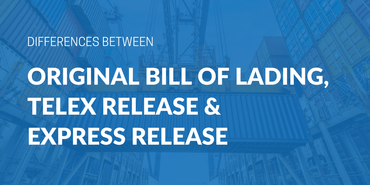
How a shipper's letter of instruction (SLI) can prevent damages to your shipment



![]()
If you’ve ever received a phone call from a driver saying, “I have a problem. I was loading your shipment on the truck, and it fell off,” you know how frustrating receiving a damaged product can be. While you may think that this is an inevitable pitfall of shipping freight, if you use the shipper’s letter of instruction (SLI), as part of your delivery order or as a separate document, you can help avoid some issues before they happen.
In this article, we will look at what exactly an SLI form is and how it can prevent damages to your shipment. The more attention you pay to these details when dealing with freight shipments, the better chance you have of maintaining good customer relations.
What exactly is an SLI?
In simple terms, it’s a written instruction from the person sending the freight to the driver of the delivering vehicle. While this can be a letter or a form attached to your delivery order, its purpose is always to provide clear and concise information about how you want your shipment handled. It will typically contain details such as:
Your name and contact number.
This way, if any questions arise while the shipment is in transit that needs clarifying, the carrier has an easy way of getting hold of you immediately. You should also attach your address so that it’s available for reference when they’re on the road.
The destination address where your shipment is being sent.
If necessary, add a note to the SLI so that it’s clear if this is a residential or commercial delivery, and if there’s anyone outside of normal business hours who needs to provide access for the driver.
Details about how you would like your shipment packed into the vehicle.
You can use terms such as “palletized” or “stacked,” which will give drivers a better idea of where to put your freight when they’re loading it onto their truck. Some shippers also add details about whether you want straps used for securing items during transit, and what kinds of boxes and other packing materials you prefer having used (e.g., avoid using styrofoam peanuts because they cause respiratory problems for some people).
Any special handling instructions that you want to be followed.
For example, if there are any hazardous materials in your shipment that require extra care, you should mention them here. You can also request that fragile items be given special attention when being loaded into the vehicle to avoid damage during transit.
A clear statement detailing who is responsible for the freight once it’s been delivered to its destination.
This will prevent any disputes arising after delivery about whose responsibility it was to make sure the cargo arrived undamaged.
How SLI in shipping prevents damages to your cargo
By using an SLI shipping form in conjunction with your delivery order, you can help ensure that the details of how you want your shipment handled are clearly understood by the truck drivers who are transporting it. This will not only prevent damages during transit but also make sure that your freight arrives at its destination undamaged.
Having an SLI form on hand gives your drivers the information they need to deliver your goods in an efficient and safe manner. It also ensures that you’ll receive undamaged freight because the driver knows exactly what you want to avoid damage during transit.
You don’t have to hand over your SLI form directly to the driver before they leave with your shipment; in fact, many shippers keep them on file so that they’re available at any time while you’re working with their carrier. By using SLI forms, you can avoid lost or misdirected shipments while also giving your customers peace of mind about how their freight is being handled.
Your customers will appreciate the extra attention to detail that you’re providing with an SLI form, and in some cases, it may be enough to keep them from filing a complaint if there are any damages. Keeping good customer relations is key for maintaining repeat business, so paying close attention to these details can help prevent headaches down the road when trying to resolve disputes.
How to write a shipper’s letter of instruction form
If you’ve ever wondered how to write a shipper’s letter of instruction form, we can help with that. This is the type of information you’ll need to include:
- Who should be contacted in case any questions arise concerning your shipment during transit.
- Whether or not you want the goods loaded onto a truck pallet and strapped down. (For fragile items and objects larger than five feet, packing instructions may also need to be included).
- Any hazardous materials which need special attention during transit – such as needing refrigeration – along with details about who is responsible for charges incurred during the delivery process related to those materials.
Shipper’s letter of instruction template
Here is a template you can follow to write an SLI that meets the shipper’s letter of instruction requirements.
Dear Shipper,
Thank you for your order!
In the event any questions arise during transit, we would appreciate it if you contacted [contact name]. If you need to make any changes along the way, please contact us as soon as possible. In addition, it is important that all records be updated regarding this shipment by close of business on [date]. Contact information appears on the front of this SLI.
Please let us know if there are any special circumstances which will affect our delivery of your order to its destination. We look forward to a successful and smooth delivery!
Best regards,
Name & Title at Company Name
Date
Now that you know how to write a shipper’s letter of instruction, you are better equipped to ship cargo anywhere in the world — without worrying about it getting lost or damaged!
- 1. What exactly is an SLI?Your name and contact number.The destination address where your shipment is being sent.Details about how you would like your shipment packed into the vehicle.Any special handling instructions that you want to be followed.A clear statement detailing who is responsible for the freight once it’s been delivered to its destination.
- 2. How SLI in shipping prevents damages to your cargo
- 3. How to write a shipper’s letter of instruction form
- 4. Shipper’s letter of instruction template
Related Articles


